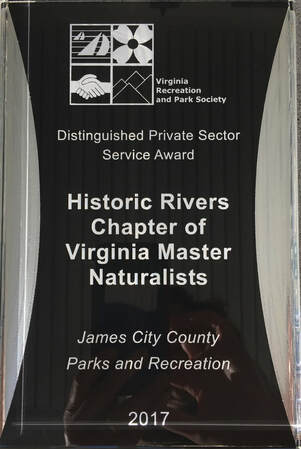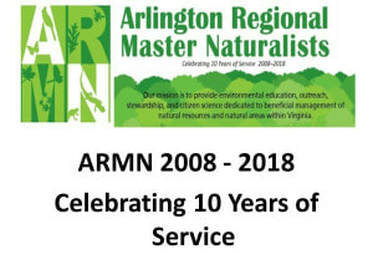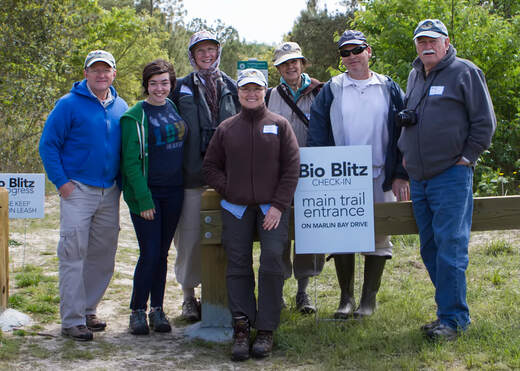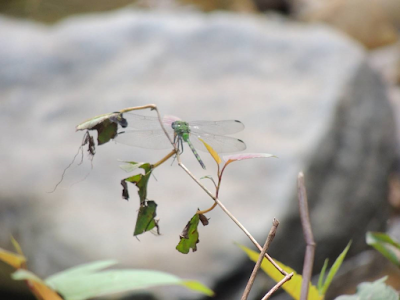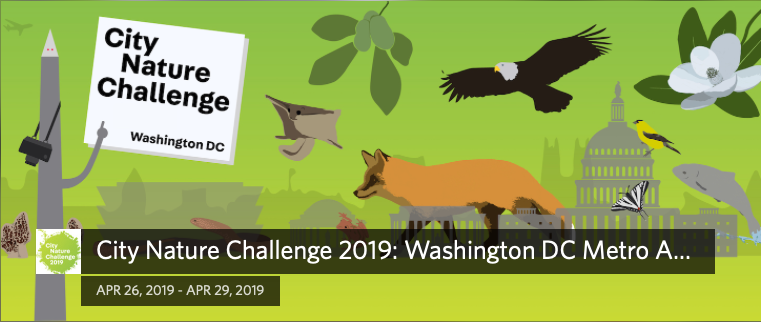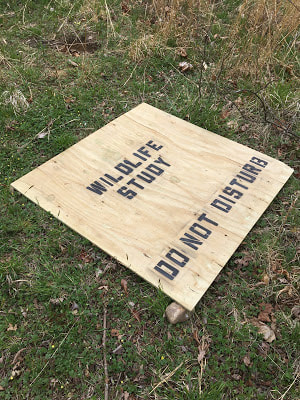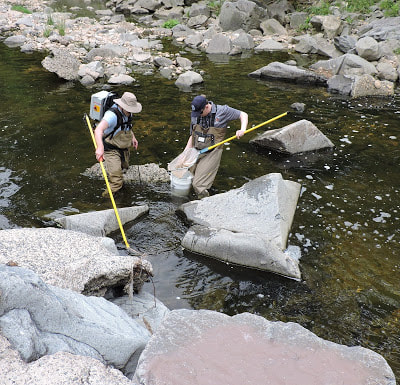This article was written and contributed by Lisa Reagan, a Virginia Master Naturalist volunteer in the Historic Rivers Chapter. Congratulations to Lisa on her find, and for maintaining habitat that allowed for this neat species!
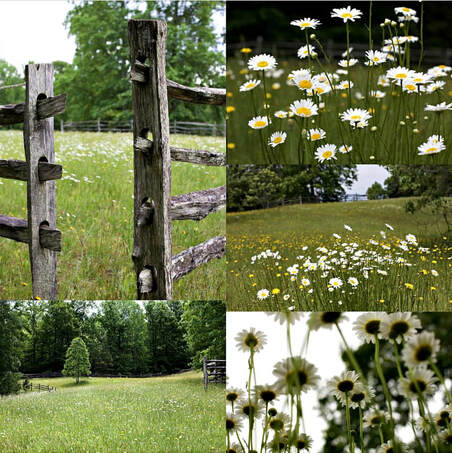 The north pasture sporting Oxeye Daisies in May 2018. The naturalized species, among others, is self-planted and supported with timed meadow management mowing. Photo by Lisa Reagan, VMN-Historic Rivers Chapter.
The north pasture sporting Oxeye Daisies in May 2018. The naturalized species, among others, is self-planted and supported with timed meadow management mowing. Photo by Lisa Reagan, VMN-Historic Rivers Chapter.
Over the past 17 years the enclosed two acres of our “north pasture” has served as a teacher for our family in meadow management, with all lessons learned through observation and modification of mowing cycles to support the natural carpeting of the hillsides with a glorious show of introduced and native flowering plants. In early May, Oxeye Daisies blanket the slopes, in June the Dandelions take their turn, and in early fall another round of Dandelions and the more approved-of native plant, Common Yarrow, finish the season.
Just a few feet across the dirt road that runs along the ridge line, a variety of completely different nonnative plant species provide evidence of early British settlers to the area: edible Yellow Hops Clover and Rabbit’s Foot Clover carpet the southern facing slope in the early spring, and sometimes again in late summer.
The eight acre farm we live on in Toano, Virginia, has been cultivated, hunted and explored for centuries by colonists and for millennia by Native Americans of the Powhatan Nation. Our double-digging of the first garden beds in 2003 revealed such a treasure of bulky 17th century German pottery, broken porcelain and medicine bottles, we happily skipped down Route 60 to Colonial Williamsburg’s archeology department and showed them our haul.
They were not impressed. “You can’t stick a shovel in the ground around here without finding these sorts of things. Call us when you find brick,” they said.
Why is it important to understand the habitat this county record-setting animal preferred? Because we did not realize that in tending a meadow of self-planted, naturalized and native plants, we were also creating and tending a habitat for a “secretive” and therefore rarely seen Eastern Slender Glass Lizard.
When I knelt down to examine the poor animal that I accidentally hit with my riding mower this past fall, NPR’s Sunday jazz show was playing in my ears through protective headphones. What I saw in the grass appeared to be a perfect music staff: rows of horizontal black lines separating bright, white spaces. I turned over the animal to see if it was injured or dying, but it was missing its head, probably from popping-up to check out the approaching rumbling. The blades are always set at the maximum height of 4 ½ inches, so I was surprised it could lift its head that high, and sad.
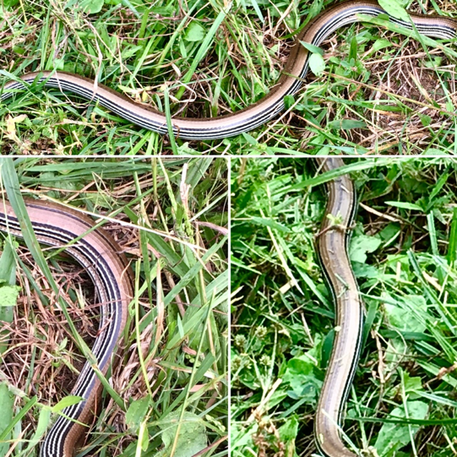 Postmortem photo of what was not a Write Your Own Song Snake, but an Eastern Slender Glass Lizard, or Ophisaurus attenuates longicaudus. The legless lizard does not qualify as a snake because it blinks its eyes and has external ears. Its preferred hunting ground is grassy land and preferred prey is grasshoppers, another distinguishing feature from snakes, who eat larger meals more infrequently.
Postmortem photo of what was not a Write Your Own Song Snake, but an Eastern Slender Glass Lizard, or Ophisaurus attenuates longicaudus. The legless lizard does not qualify as a snake because it blinks its eyes and has external ears. Its preferred hunting ground is grassy land and preferred prey is grasshoppers, another distinguishing feature from snakes, who eat larger meals more infrequently.
I grew sadder as I marveled at the second music staff running along the length of the opposite side of its body: two lateral music staffs extended from neck to tail separated by an unusual glossy, bronze color bisected by a black, middorsal stripe. Back in the house, none of my field guides, or online websites, showed a haute couture snake sporting a set of music staffs. Hmm… a “Write Your Own Song Snake,” I mused, before emailing the
Virginia Herpetological Society, VHS, with my photos and a request for help in identifying the animal.
“Wow! How cool is that!” came the reply a few hours later from a group of herpetologists. “The animal is an Eastern Slender Glass Lizard. These are legless lizards. Your discovery represents the first observation of this species in James City County.” The team pointed me to a page on the Virginia Herpetological Society’s website to formally document the “County Record” as a Field Note to be published in the VHS’ bi-annual journal, Catesbeiana. (You can find instructions for this process here.)
Not only was the VHS team as enthusiastic about the find as I was, Paul Sattler, PhD, editor of Catesbeiana, answered my questions about the legless lizard on the phone. As a newly graduated master naturalist (from the Historic Rivers Chapter in 2018), I was deeply grateful for their replies and instructions.
Why was the animal in the north pasture? Why would it be a county record? Why aren’t there many around? The Eastern Slender Glass Lizard, Ophisaurus attenuates longicaudus, is secretive and seldom seen “because they stay in abandoned rodent burrows and under mats of dead grass and other decomposing plant materials.” O. attenuates are “always associated with grassy areas,” but, “Once old field succession reaches the stage where pine and hardwood trees shade the ground, glass lizards decline in numbers,” stated the VHS website.
The website explained that the historical decline of the glass lizard population is attributed to the lack of grassland habitat due to both successional changes and direct habitat loss. Its preferred prey species – grasshoppers – have also declined from overuse of pesticides.
As a testament to the glass lizard’s former notoriety, a substantial body of folklore exists around their ability to autotomize their tails. Believing the glass lizard to be a snake, folklore tales claim the broken pieces will grow back together after sunset and form a complete “snake” again. A series of notes in the Martinsville Daily Bulletin in September 1967 describe just such an incident, and the people involved claimed they saw the pieces reassembling.
It’s easy to see how anyone could mistake the glass lizard for a snake. However, legless lizard
s differ from snakes because they have eyelids (can blink), external ears and eat smaller, more frequent meals than snakes.
As part of its conservation of Virginia’s native, wild herpetofauna, and specifically the glass lizard, the VHS recommends that, “Observations of any kind should be reported,” and that, “Any consideration of long-term management for this species must include the maintenance of grassland habitat.”
And this is why official county records are important to conservation efforts, explained Sattler in a phone call. “We have to tell the state what we found and where and how many every year. The state enters all of that information into the database at the US Fish and Wildlife Service. They keep a record for each county and have for decades. For James City County, there has never been a glass lizard reported. This is the first one. That’s why it is a new county record.”
Dr. Sattler graciously eased my conscience about hitting the beautiful legless lizard and offered a little kudos on meadow management. “Because you’ve maintained the habitat, they have a safe place to live. It’s great you hit the one you did so you know that they are there. It’s great that you have the photo and video of where you found it,” he said.
The Eastern Slender Glass Lizard James City County Record was published as an official Field Note in the Fall 2018 issue of Catesbeiana this past December. My original Sunday jazz inspired name for the animal, the Write Your Own Song Snake, will remain an inside joke in our family, continuing the glass lizard’s long folklore tradition. I promise to turn down the headphone volume and keep an eye out for our new meadow resident this year.
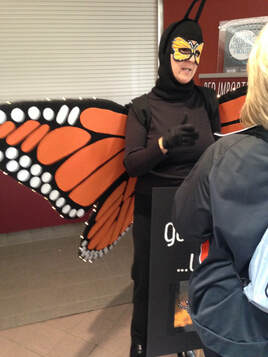 VMN-New River Valley volunteer dons wings to educate community members about pollinators and their habitat at the 2018 Hokie BugFest. Photo contributed by Judy Kirwan, VMN-New River Valley Chapter.
VMN-New River Valley volunteer dons wings to educate community members about pollinators and their habitat at the 2018 Hokie BugFest. Photo contributed by Judy Kirwan, VMN-New River Valley Chapter. 
